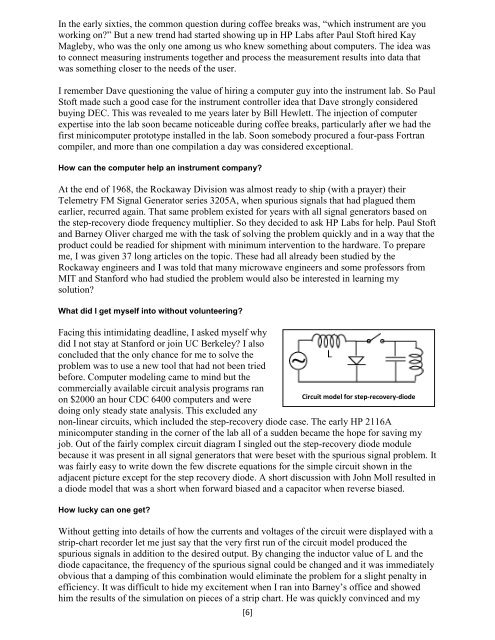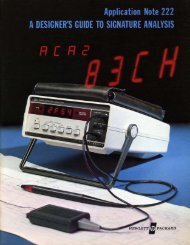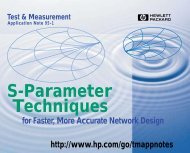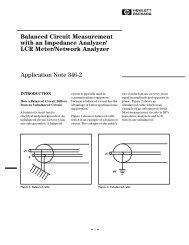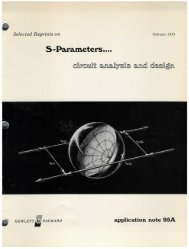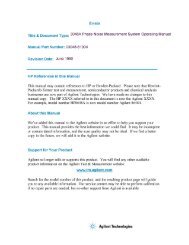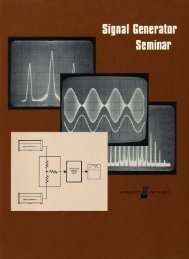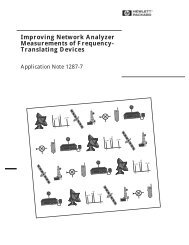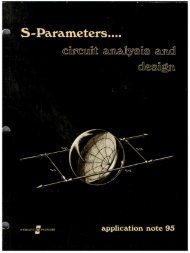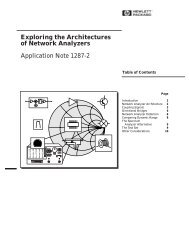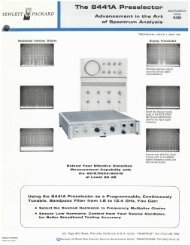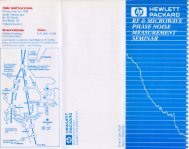My Association with HP - HP Memory Project
My Association with HP - HP Memory Project
My Association with HP - HP Memory Project
You also want an ePaper? Increase the reach of your titles
YUMPU automatically turns print PDFs into web optimized ePapers that Google loves.
In the early sixties, the common question during coffee breaks was, “which instrument are youworking on?” But a new trend had started showing up in <strong>HP</strong> Labs after Paul Stoft hired KayMagleby, who was the only one among us who knew something about computers. The idea wasto connect measuring instruments together and process the measurement results into data thatwas something closer to the needs of the user.I remember Dave questioning the value of hiring a computer guy into the instrument lab. So PaulStoft made such a good case for the instrument controller idea that Dave strongly consideredbuying DEC. This was revealed to me years later by Bill Hewlett. The injection of computerexpertise into the lab soon became noticeable during coffee breaks, particularly after we had thefirst minicomputer prototype installed in the lab. Soon somebody procured a four-pass Fortrancompiler, and more than one compilation a day was considered exceptional.How can the computer help an instrument company?At the end of 1968, the Rockaway Division was almost ready to ship (<strong>with</strong> a prayer) theirTelemetry FM Signal Generator series 3205A, when spurious signals that had plagued themearlier, recurred again. That same problem existed for years <strong>with</strong> all signal generators based onthe step-recovery diode frequency multiplier. So they decided to ask <strong>HP</strong> Labs for help. Paul Stoftand Barney Oliver charged me <strong>with</strong> the task of solving the problem quickly and in a way that theproduct could be readied for shipment <strong>with</strong> minimum intervention to the hardware. To prepareme, I was given 37 long articles on the topic. These had all already been studied by theRockaway engineers and I was told that many microwave engineers and some professors fromMIT and Stanford who had studied the problem would also be interested in learning mysolution?What did I get myself into <strong>with</strong>out volunteering?Facing this intimidating deadline, I asked myself whydid I not stay at Stanford or join UC Berkeley? I alsoconcluded that the only chance for me to solve theproblem was to use a new tool that had not been triedbefore. Computer modeling came to mind but thecommercially available circuit analysis programs ranon $2000 an hour CDC 6400 computers and wereCircuit model for step-recovery-diodedoing only steady state analysis. This excluded anynon-linear circuits, which included the step-recovery diode case. The early <strong>HP</strong> 2116Aminicomputer standing in the corner of the lab all of a sudden became the hope for saving myjob. Out of the fairly complex circuit diagram I singled out the step-recovery diode modulebecause it was present in all signal generators that were beset <strong>with</strong> the spurious signal problem. Itwas fairly easy to write down the few discrete equations for the simple circuit shown in theadjacent picture except for the step recovery diode. A short discussion <strong>with</strong> John Moll resulted ina diode model that was a short when forward biased and a capacitor when reverse biased.How lucky can one get?Without getting into details of how the currents and voltages of the circuit were displayed <strong>with</strong> astrip-chart recorder let me just say that the very first run of the circuit model produced thespurious signals in addition to the desired output. By changing the inductor value of L and thediode capacitance, the frequency of the spurious signal could be changed and it was immediatelyobvious that a damping of this combination would eliminate the problem for a slight penalty inefficiency. It was difficult to hide my excitement when I ran into Barney’s office and showedhim the results of the simulation on pieces of a strip chart. He was quickly convinced and my[6]


